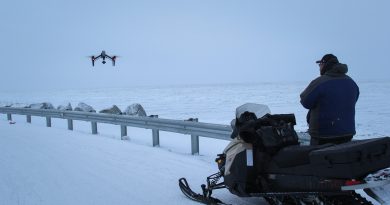Old chart identified as artifact from ill-fated Arctic voyage of the Karluk

A stained and torn navigational chart donated two years ago to a museum in Maine turns out to be a document used on an infamous and ill-fated Arctic exploration voyage a century ago, experts say.
The chart, of the marine areas in western Alaska and adjacent parts of Russia, has been confirmed as an item used by Robert Bartlett, captain of the Karluk, a ship that was the center of a 1914 wreck off the Siberian coast, said officials at the Peary-MacMillan Arctic Museum and Arctic Studies Center at Bowdoin College.
“We’re just amazed it survived,” said Susan Kaplan, a Bowdoin anthropology professor and director of the museum.
At first glance, the linen-backed chart — which was among several items donated to the museum by one of Bartlett’s relatives — may not seem very impressive, Kaplan said. It is fragile, “rather grimy” and ripped in one section, she said. It is also marked up with dates, she said.
But those dates correlate to the movements and wreck of the Karluk, the tear matches one seen on an old photograph of Bartlett holding a chart, and the dirt and stains help explain “what it and Bartlett went through,” Kaplan said.
Escape to Wrangel Island
Bartlett and the Karluk were hired by Canadian explorer Vilhjamur Stefansson to carry out the Canadian Arctic Expedition. The expedition, launched in 1913, was supposed to use its first voyage to travel from British Columbia through the Bering Strait to the Canadian Beaufort Sea. But the ship got stuck in ice north of the Bering Strait and was blown far off course, heading into Siberian waters. Just before the ship was crushed in the ice and sank on Jan. 10, 1914, the crew abandoned the Karluk and fled over the ice to Russia’s Wrangel Island. Bartlett also abandoned ship, but not before collecting his charts and supplies, Kaplan said.
Eleven crew members died on Wrangel Island, or died trying to get there.
“It was what I characterize as a slow-moving disaster,” Kaplan said.
The Karluk disaster has become part of Arctic lore.
Specialist to work on chart
Bartlett — an experienced Arctic mariner and a colleague of Robert Peary — is considered one of the story’s heroes because of the 700-mile trip he and an Inupiat companion made over snow and ice to summon help from the Russian mainland. The surviving crew members were rescued eight months after the Karluk sank.
Stefansson, the expedition leader, has been criticized by historians for what were considered to be his ill-advised attempts in subsequent years to claim Wrangel Island as Canadian territory, a campaign that resulted in deaths of four people who were trying to colonize the remote site that is now a nature reserve.
As for the now-identified Bartlett chart, the museum’s plan is to hire a specialist to work on “stabilizing it so it doesn’t completely fall apart,” and then putting the chart on exhibit, Kaplan said.
“Objects have stories, and sometimes you’re lucky and you can discover the story,” she said.
Related stories from around the North:
Canada: The discovery of an Arctic shipwreck, Radio Canada International
Finland: Heritage hunting in Finnish forests, Yle News
Norway: History revealed by WW2 wrecks in Norway’s Arctic fjords, Barents Observer
Russia: Russia’s Arctic culture heritage sites get protection, Barents Observer
United States: Crews unearth military history on Alaska Glacier, Alaska Dispatch



